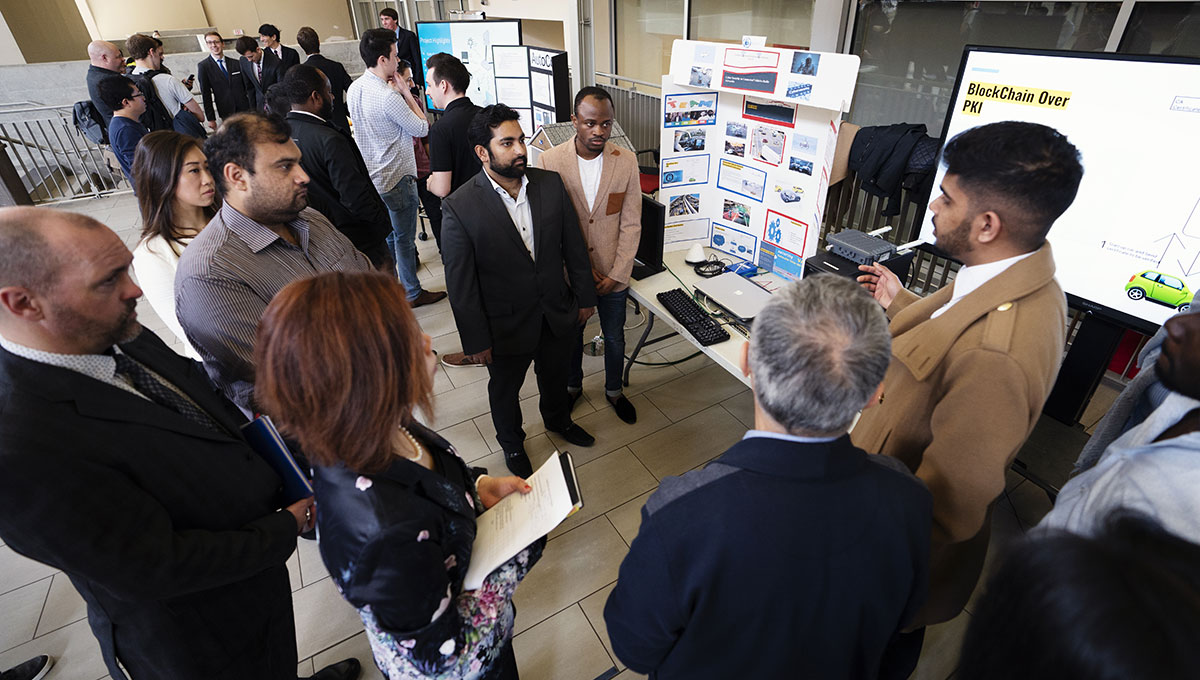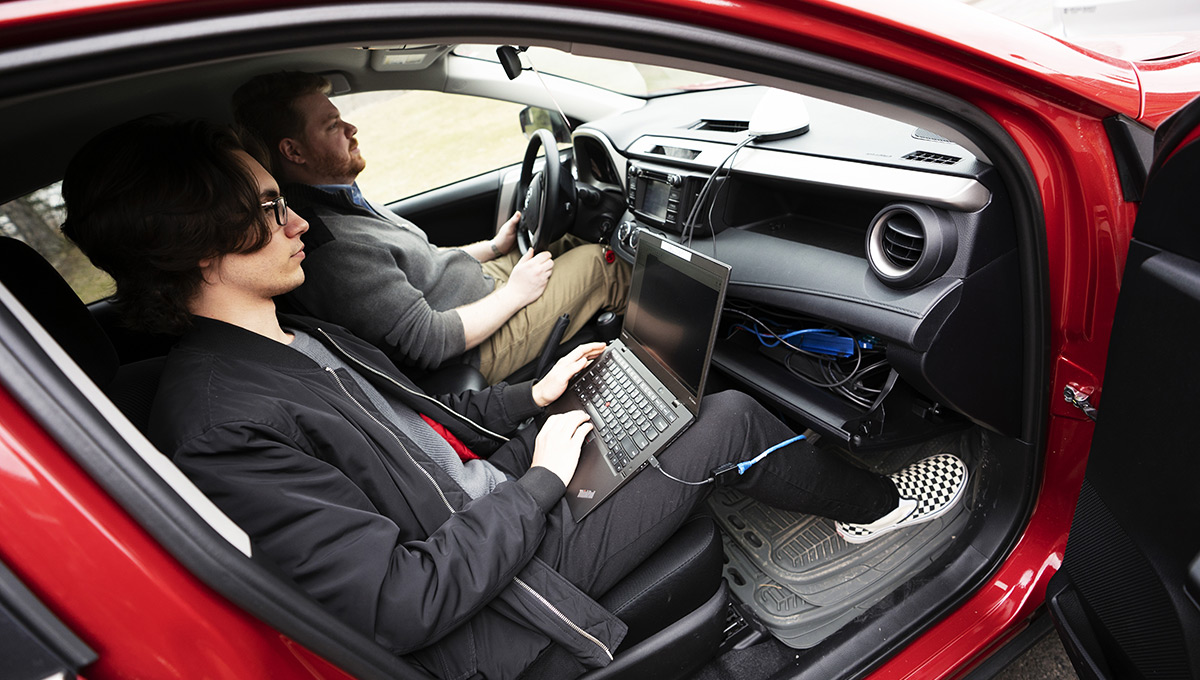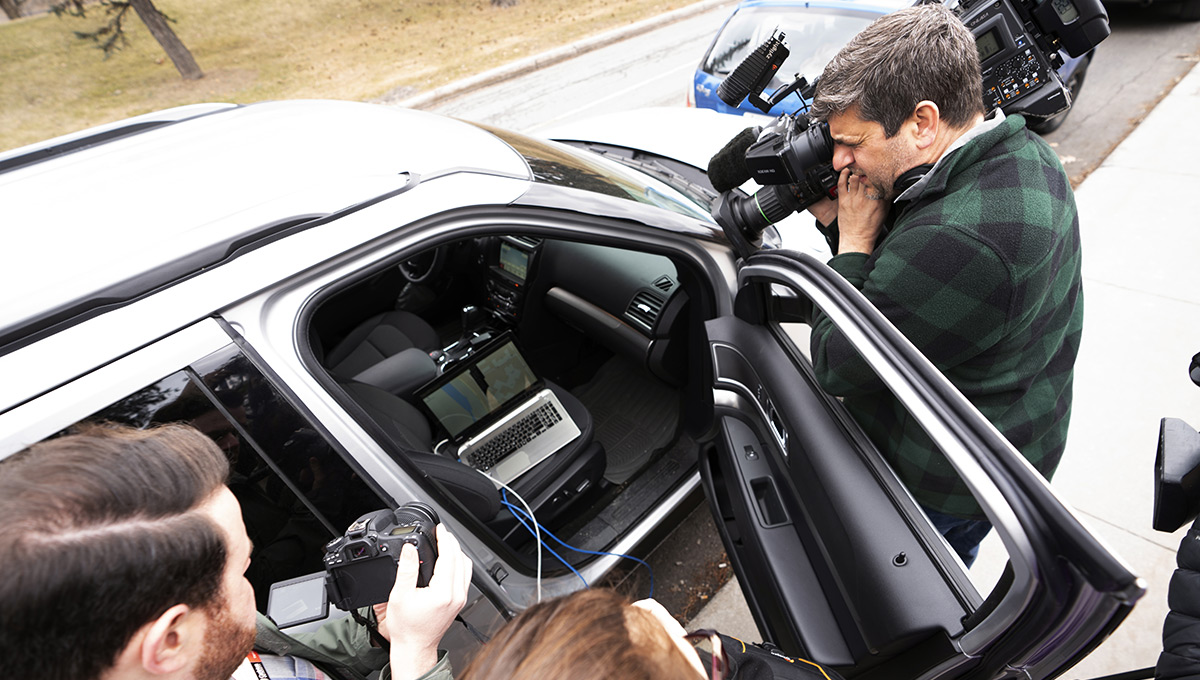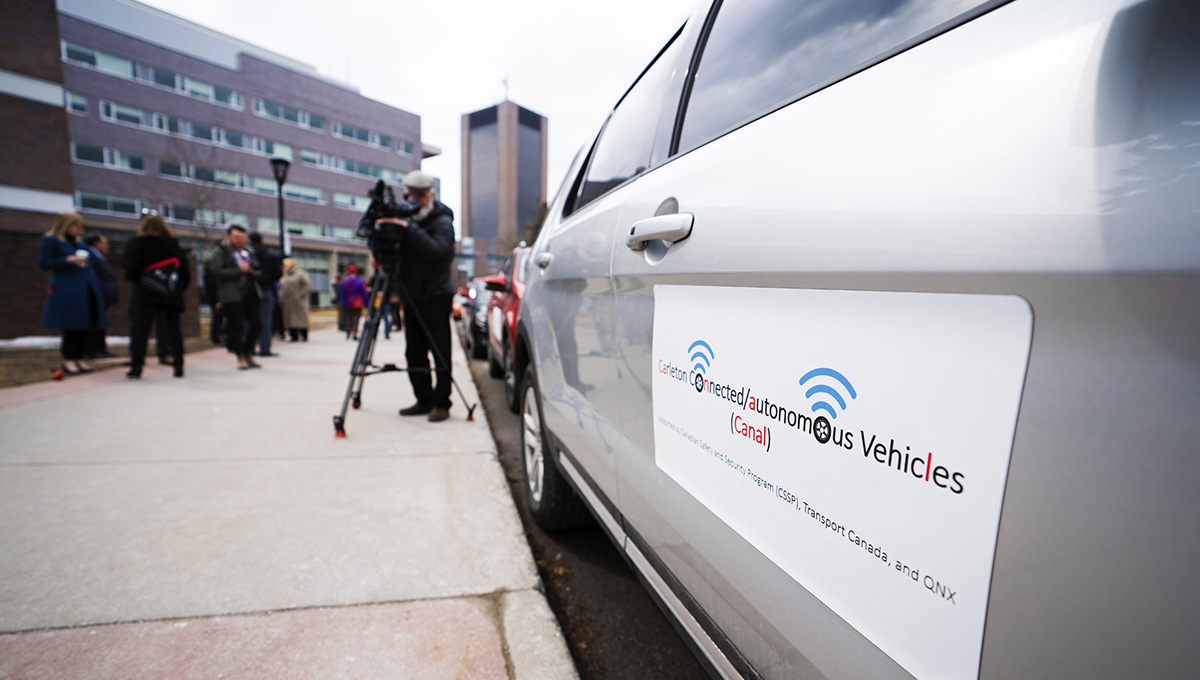By Dan Rubinstein
Photos by Chris Roussakis
A pair of Carleton University students sit in the front seats of a red Toyota RAV4 parked on Library Road outside the Mackenzie Building.
A few seconds later, one of their classmates in the Bachelor of Information Technology (BIT) program gets behind the wheel of a grey Ford Explorer parked in front and opens a laptop on the passenger seat.
After the man in the Explorer attaches a few cables to the computer and steps outside to put a Cohda Wireless communications device called a Roadside Unit (RSU) on the roof, the RAV4 pulls away from the curb and begins to drive north.
The red car curves east along Library Road and is soon out of sight, but not out of contact. A map on the laptop’s screen shows its location, speed, braking status and other parameters thanks to an On-Board Unit (OBU) in the RAV4 — and the networking and coding prowess of Carleton undergraduates.
This demonstration of connected vehicle technology on April 12, organized by Prof. Richard Yu, who is cross-appointed to the School of Information Technology and Department of Systems and Computer Engineering, is part of the university’s contribution to Ottawa’s evolution into an international R&D hub for connected and autonomous vehicles.
“Most car accidents happen because you don’t know what other vehicles are doing or going to do,” says Yu, whose connected and autonomous car research is supported by Defence Research and Development Canada and Public Safety Canada’s Canadian Safety and Security Program (CSSP).
“We can prevent accidents by developing the communications technology that allows vehicles to know what’s happening in the environment and with other vehicles.”
The on-campus demo used cars purchased by Carleton with support from the CSSP, Transport Canada and BlackBerry software subsidiary QNX, which operates the Autonomous Vehicle Innovation Centre at its Kanata headquarters. Yu’s research on improving the security and bandwidth of super-fast 5G wireless networks is an important piece of this puzzle.
“The research we do here at Carleton on fully autonomous vehicles will lead to the introduction of more efficient active safety features that will improve road safety,” says Vice-President (Research and International) Rafik Goubran. “Additionally, increasing the automation level in vehicles will extend the number of years of driving for older drivers, assisting with their mobility and social engagement. It will also increase accessibility for all persons.”

Securing Autonomous Vehicles
Before heading outside to watch the cars communicate with each other and respond to a simulated cyberattack, Carleton faculty and students — and visitors from government agencies and local technology companies — gathered in the University Centre galleria for poster presentations by Yu’s students in the BIT program’s network technology stream.
Messages transmitted by OBUs are vulnerable to cyberattacks, says Syed Ali, a fourth-year BIT student who worked with five others on a final-year capstone project to show how advanced cryptography techniques can bolster security for connected and autonomous vehicles.

Prof. Richard Yu
If a hacker makes a car believe that it has approached a red light, Ali says, it could come to a sudden stop, potentially setting off a chain-reaction accident.
A natural remedy to this risk is advanced encryption, but if that makes messages sent between connected vehicles too large and cumbersome, the rapid rate at which they need to communicate to travel safely will be compromised.
“For connected vehicles, every tiny fraction of a second counts,” says Ali, explaining that new types of encryption techniques are required.
“The communication needs to be as quick and seamless as possible without limiting security. That’s what we’re trying to address. People who work on connected vehicles don’t always think about cybersecurity as much as they should.”

A Lab for Real-World Performance Measurements
Another fourth-year student, Nathan Wittich, worked with three classmates on a project to develop apps for connected and autonomous vehicle performance testing.
In the context of a newly allotted wireless communications spectrum (DSRC) and a new wireless communications protocol that allows vehicles to communicate with infrastructure and possibly the Internet, the goal of Wittich’s group was to establish a lab for equipment evaluation and initial field trials to do preliminary real-world performance measurements — such as the road test on the Carleton campus.
“Connected and autonomous vehicles require a lot of enabling technologies,” says Wittich.
“These technologies are here and they are working. Vehicles can communicate with each other and with roadside infrastructure. Connected vehicles ‘know’ more than what you can see from the car, and they will be everywhere soon enough, but there’s a lot of research that will have to be done in a lot of different fields before their widespread deployment.”

A laptop displays communication between two vehicles
Another group of Yu’s students at the poster fair focused on simulating cyberattacks — such as a fake traffic jam and a fake deployment of dozens of police cars.
Non-vehicle projects on display included research on smart home automation, a remote water quality testing device for real-time monitoring of lakes, and a blockchain supply management system.
“It’s important for students to have this kind of training,” says Yu, referring specifically to the car-related projects and demonstration, but also reflecting all of the work on display. “And with connected and autonomous vehicles developing so rapidly, there is so much work to be done.
“Cybersecurity is a big issue right now,” he continues. “We need to make sure vehicles are safe and that we can trust them, which is a big focus for the industry and for government regulators. With more information being exchanged by vehicles, travel will become smarter and more efficient.
“Because both government and industry are here in the Ottawa area, this is a good place to do this kind of work,” adds Yu, “and there are opportunities for students to get good jobs.”

Wednesday, April 18, 2018 in Innovation, Research
Share: Twitter, Facebook



